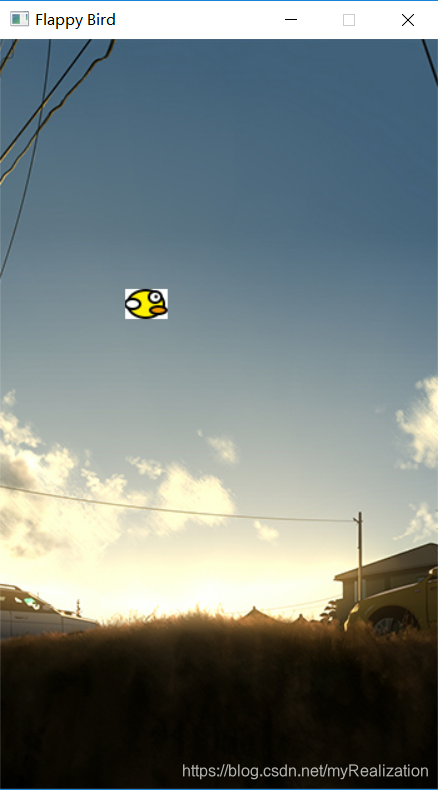前言
除了利用控制台打印字符,我们还可以用图片、音乐等素材,开发出更加精彩的游戏。
点子
这里开发出图形版的flappy bird。
具体实现
1. 导入图片背景和小鸟
使用loadimage和putimage,导入背景图和小鸟图片。
其中,文件名路径都是LPCTSTR,这是什么类型?简单说,这是一个字符串指针。原因在于用路径中可能有英文字符,也可能有中文字符,中文字符使用两个字节作为一个字符(汉字机内码)。官方文档明确提及了这个问题:
中文版错误提示如下:error C2665: “outtextxy”: 2 个重载中没有一个可以转换所有参数类型
英文版错误提示如下:error C2665: ‘outtextxy’ : none of the 2 overloads could convert all the argument types
同样的,对于其他一些包含字符串调用的函数,例如 loadimage、drawtext 等,也会遇到类似问题。
【错误原因】
简单来说,这是由于字符编码问题引起的。VC6 默认使用的 MBCS 编码,而 VC2008 及高版本 VC 默认使用的 Unicode 编码。以下详细解释这个问题:
用 char 表示字符时,英文占用一个字节,中文站用两个字节。这样有一个严重的问题:两个连续字节,究竟是两个英文字符,还是一个中文字符?为了解决这个问题,Unicode 编码诞生了。Unicode 编码不管中文英文都用两个字节表示。
对于 MBCS 编码,字符变量用 char 定义。对于 Unicode 编码中,字符变量用 wchar_t 定义。为了提高代码的自适应性,微软在 tchar.h 里面定义了 TCHAR,而 TCHAR 会根据项目定义的编码,自动展开为 char 或 wchar_t。
在 Windows API 和 EasyX 里面的大多数字符串指针都用的 LPCTSTR 或 LPTSTR 类型,LPCTSTR / LPTSTR 就是“Long Point (Const) Tchar STRing”的缩写。所以可以认为,LPCTSTR 就是const TCHAR *,LPTSTR 就是TCHAR *。
于是,在 VS2008 里面,给函数传递 char 字符串时,就会提示前述错误。
为了让代码适应char和wchar_t两种情况,可以用TCHAR宏,这个宏当项目定义为unicode时表示wchar_t,否则表示char。
对应的,还有 _T("") 宏用来表示字符串。
#include <easyx.h>
#include <conio.h>
int main() {
initgraph(350, 600);
IMAGE img_bk, img_bird;
loadimage(&img_bk, _T("..\\source\\background.jpg"));
putimage(0, 0, &img_bk);
loadimage(&img_bird, _T("..\\source\\bird2.jpg"));
putimage(100, 200, &img_bird);
_getch();
closegraph();
return 0;
}
效果:

2. 用遮罩图解决小鸟边框
小鸟的图片不是透明的,带有明显的白色边框,因此,我们需要利用小鸟的遮罩图bird1.jpg,它与bird2.jpg像素一一对应,bird1中白色的像素区域将bird2中对应的像素显示,bird1中黑色的区域将bird2中对应的像素隐藏。对应的遮罩图可以通过PS抠图生成。
这里必须了解三元光栅操作码。看文档就可以了。
#include <easyx.h>
#include <conio.h>
int main() {
initgraph(350, 600);
IMAGE img_bk;
loadimage(&img_bk, _T("..\\source\\background.jpg"));
putimage(0, 0, &img_bk);
IMAGE img_bd1, img_bd2;
loadimage(&img_bd1, _T("..\\source\\bird1.jpg"));
loadimage(&img_bd2, _T("..\\source\\bird2.jpg"));
//putimage(100, 200, &img_bd1, DSTINVERT); //绘制出的像素颜色 = NOT 屏幕颜色
putimage(100, 200, &img_bd1, NOTSRCERASE); //绘制出的像素颜色 = NOT (屏幕颜色 OR 图像颜色)
//putimage(100, 200, &img_bd2, SRCAND); //绘制出的像素颜色 = 屏幕颜色 AND 图像颜色
//putimage(100, 200, &img_bd2, SRCCOPY); //绘制出的像素颜色 = 图像颜色
//putimage(100, 200, &img_bd2, SRCERASE); //绘制出的像素颜色 = (NOT 屏幕颜色) AND 图像颜色
putimage(100, 200, &img_bd2, SRCINVERT); //绘制出的像素颜色 = 屏幕颜色 XOR 图像颜色
//putimage(100, 200, &img_bd2, SRCPAINT); //绘制出的像素颜色 = 屏幕颜色 OR 图像颜色
_getch();
closegraph();
return 0;
}

3. 用游戏框架重构flappy bird游戏
将前面的字符版flappy bird的游戏框架搬过来,让小鸟自由下落和操作上升:
#include <easyx.h>
#include <conio.h>
#include <windows.h>
IMAGE img_bk, img_bd1, img_bd2, img_bar_up1, img_bar_up2, img_bar_down1, img_bar_down2;
int bird_x, bird_y;
void initgame() {
initgraph(350, 600);
loadimage(&img_bk, _T("..\\source\\background.jpg")); //350 x 600
loadimage(&img_bd1, _T("..\\source\\bird1.jpg")); //34 x 24
loadimage(&img_bd2, _T("..\\source\\bird2.jpg"));
loadimage(&img_bar_up1, _T("..\\source\\bar_up1.gif")); //140 x 600
loadimage(&img_bar_up2, _T("..\\source\\bar_up2.gif"));
loadimage(&img_bar_down1, _T("..\\source\\bar_down1.gif"));
loadimage(&img_bar_down2, _T("..\\source\\bar_down2.gif"));
bird_x = 50, bird_y = 200;
BeginBatchDraw();
}
void show() {
//显示背景
putimage(0, 0, &img_bk);
//显示小鸟
putimage(bird_x, bird_y, &img_bd1, NOTSRCERASE); //绘制出的像素颜色 = NOT (屏幕颜色 OR 图像颜色)
putimage(bird_x, bird_y, &img_bd2, SRCINVERT); //(XOR)方式 绘制出的像素颜色 = 屏幕颜色 XOR 图像颜色
//显示上面的障碍物
putimage(150, -300, &img_bar_up1, NOTSRCERASE);
putimage(150, -300, &img_bar_up2, SRCINVERT);
//显示下面的障碍物
putimage(150, 400, &img_bar_down1, NOTSRCERASE);
putimage(150, 400, &img_bar_down2, SRCINVERT);
FlushBatchDraw();
}
void updateWithoutInput() {
if (bird_y < 570) bird_y += 5;
Sleep(150); //减缓小鸟的下落速度和柱子移动速度
}
void updateWithInput() {
char input;
if (_kbhit()) {
input = _getch();
if (input == ' ' && bird_y > 20) bird_y -= 30;
}
}
void gameover() {
EndBatchDraw();
_getch();
closegraph();
}
int main() {
initgame();
while (1) {
show();
updateWithInput();
updateWithoutInput();
}
return 0;
}

4. 导入声音
播放音乐需要用mciSendString函数。需要先打开(open)音乐,再就可以循环(play … repeat)播放、仅播放一次(play)、关闭(close)前面的音乐。
#pragma comment(lib, "Winmm.lib")
void initgame() {
...
mciSendString(_T("open ..\\source\\background.mp3 alias bk_music"), NULL, 0, NULL); //打开音乐
mciSendString(_T("play bk_music repeat"), NULL, 0, NULL); //循环播放音乐
...
}
void updateWithInput() {
char input;
if (_kbhit()) {
input = _getch();
if (input == ' ' && bird_y > 20) {
bird_y -= 30;
mciSendString(_T("close jpmusic"), NULL, 0, NULL); //先把前面一次的音乐关闭
//打开音乐
mciSendString(_T("open ..\\source\\Jump.mp3 alias jpmusic"), NULL, 0, NULL);
mciSendString(_T("play jpmusic"), NULL, 0, NULL); //仅播放一次
}
}
}
...
5. 实现柱子的移动和碰撞检测
这里需要范围检查,不仅仅是像字符版那样。
#include <easyx.h>
#include <conio.h>
#include <string>
#include <windows.h>
#pragma comment(lib, "Winmm.lib")
using namespace std;
IMAGE img_bk, img_bd1, img_bd2, img_bar_up1, img_bar_up2, img_bar_down1, img_bar_down2;
int bird_x, bird_y;
int bar_yTop, bar_yDown, bar_x; //障碍物坐标
HWND hwnd;
//int score; //分数
int exitflag = 0; //退出标记
void initgame() {
initgraph(400, 600);
loadimage(&img_bk, _T("..\\source\\background.jpg"), 400, 600, false); //350 x 600
loadimage(&img_bd1, _T("..\\source\\bird1.jpg")); //34 x 24
loadimage(&img_bd2, _T("..\\source\\bird2.jpg"));
loadimage(&img_bar_up1, _T("..\\source\\bar_up1.gif")); //140 x 600
loadimage(&img_bar_up2, _T("..\\source\\bar_up2.gif"));
loadimage(&img_bar_down1, _T("..\\source\\bar_down1.gif"));
loadimage(&img_bar_down2, _T("..\\source\\bar_down2.gif"));
mciSendString(_T("open ..\\source\\background.mp3 alias bk_music"), NULL, 0, NULL); //打开音乐
mciSendString(_T("play bk_music repeat"), NULL, 0, NULL); //循环播放音乐
hwnd = GetHWnd();
bird_x = 50, bird_y = 250;
bar_yTop = 300, bar_yDown = 400, bar_x = 220;
//score = 0;
BeginBatchDraw();
}
void show() {
//显示背景
putimage(0, 0, &img_bk);
//显示小鸟
putimage(bird_x, bird_y, &img_bd1, NOTSRCERASE); //绘制出的像素颜色 = NOT (屏幕颜色 OR 图像颜色)
putimage(bird_x, bird_y, &img_bd2, SRCINVERT); //(XOR)方式 绘制出的像素颜色 = 屏幕颜色 XOR 图像颜色
//outtextxy(200, 350, _T("score"));
//显示上面的障碍物
putimage(bar_x, -300, &img_bar_up1, NOTSRCERASE);
putimage(bar_x, -300, &img_bar_up2, SRCINVERT);
//显示下面的障碍物
putimage(bar_x, bar_yDown, &img_bar_down1, NOTSRCERASE);
putimage(bar_x, bar_yDown, &img_bar_down2, SRCINVERT);
FlushBatchDraw();
}
void updateWithoutInput() {
bar_x -= 5;
if (bar_x + 140 <= 0) bar_x = 300; //重新出现柱子
if (bird_x >= bar_x && bird_x <= bar_x + 140) { //判断是否相撞
if (bird_y <= bar_yTop || bird_y >= bar_yDown) {
MessageBox(hwnd, TEXT("胜败乃兵家常事,少侠请重新再来!"), _T("结果"), MB_OK);
system("pause");
exitflag = 1;
} //else score++;
}
if (bird_y < 570) bird_y += 5; //小鸟自己下落
Sleep(150); //减缓小鸟的下落速度和柱子移动速度
}
void updateWithInput() {
char input;
if (_kbhit()) {
input = _getch();
if (input == ' ' && bird_y > 20) {
bird_y -= 20;
mciSendString(_T("close jpmusic"), NULL, 0, NULL); //先把前面一次的音乐关闭
mciSendString(_T("open ..\\source\\Jump.mp3 alias jpmusic"), NULL, 0, NULL); //打开音乐
mciSendString(_T("play jpmusic"), NULL, 0, NULL); //仅播放一次
}
}
}
void gameover() {
EndBatchDraw();
_getch();
closegraph();
}
int main() {
initgame();
while (1) {
show();
updateWithoutInput();
updateWithInput();
if (exitflag) break;
}
gameover();
return 0;
}
效果:

























 387
387











 被折叠的 条评论
为什么被折叠?
被折叠的 条评论
为什么被折叠?










